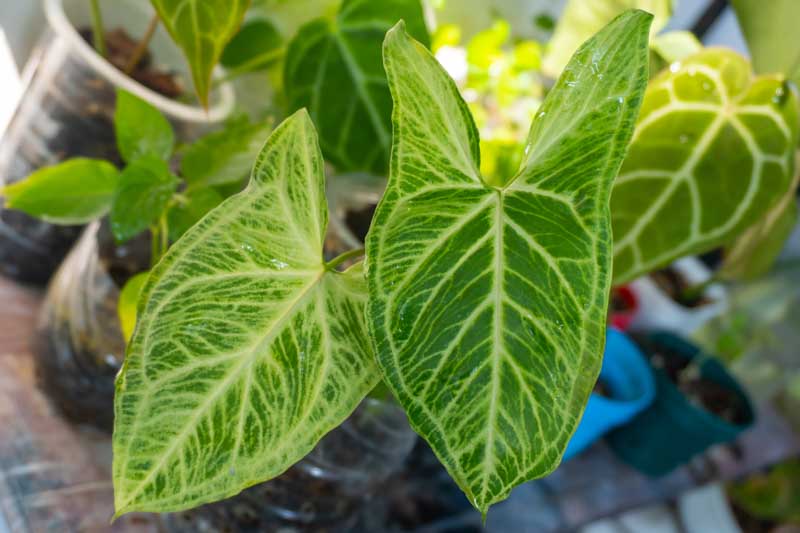African Evergreen, American Evergreen, Arrow-Head Vine, Arrowhead Vine, Green Gold Naphthysis, Nephthytis, Trileaf Wonder
Syngonium podophyllum, commonly known as the Arrowhead Plant, is a versatile and attractive houseplant that brings a touch of the tropics to any indoor space. Its appeal lies in its beautiful foliage, ease of care, and adaptability, making it a popular choice for plant enthusiasts of all levels.
Syngonium podophyllum showcases arrow-shaped leaves that change form as the plant matures, evolving from a simple arrow shape to a more complex, lobed configuration.
Native: This species is native to tropical rainforests in Central and South America, thriving in warm and humid conditions. It belongs to the arum family (Araceae), along with Zantedeschia (Calla Lily), Caladium (Angel Wing), Monstera (Swiss Cheese Plant), or Colocasia (Elephant Ear).
Plant Type and Habit: It is an evergreen climber or trailing vine that can grow upright when young but tends to sprawl or climb with age, especially if given support to attach to.
Size: In indoor settings, Syngonium podophyllum can reach up to 3-6 feet in height and spread, depending on the variety and growing conditions.
Flowers: While it can bloom indoors, its flowers are typically inconspicuous. The plant is primarily grown for its foliage.
Foliage: The plant’s dynamic foliage is its defining trait, effortlessly enlivening indoor settings. Its leaves mature from substantial, arrow-shaped forms, richly veined and interlaced with silvery-white, into lobed varieties segmented into 5-11 slender, finger-like leaflets, showcasing a stunning evolution of texture and color.
Hardiness: When grown outdoors, it is hardy in USDA zones 10-12. It is not frost-tolerant. Indoors, it thrives at average room temperatures between 60°F and 85°F (15°C to 29°C) and requires high humidity levels.
Award: Recipient of the prestigious Award of Garden Merit of the Royal Horticultural Society.
Uses: Syngonium podophyllum is primarily used as an ornamental indoor plant. It’s suitable for hanging baskets, as a climbing plant with support, or simply as a beautiful, standalone potted plant.
Toxicity: The plant is toxic if ingested due to calcium oxalate crystals, which can cause irritation and swelling of the mouth and digestive tract. It should be kept away from pets and children.
Benefits: Beyond its aesthetic appeal, it is known for its air-purifying qualities, capable of removing certain toxins from the environment.
Growing and caring for Syngonium podophyllum involves understanding its light, water, humidity, and soil preferences.
Light: Syngonium podophyllum prefers bright, indirect light but can tolerate lower light levels. Avoid direct sunlight, which can scorch its leaves. A spot near a window with sheer curtains is ideal.
Soil: Use a well-draining potting mix. A mixture of peat, perlite, and vermiculite is suitable for ensuring good drainage and aeration.
Water: Keep the soil consistently moist but not waterlogged. Water when the top inch of soil feels dry to the touch. Reduce watering in the winter months when the plant’s growth slows.
Temperature and Humidity: Thrives at average room temperatures between 60°F to 85°F (15°C to 29°C) and requires high humidity levels. Regular misting, placing it in a bathroom with natural light, or using a humidifier can help meet its humidity needs.
Fertilization: Feed with a balanced, water-soluble fertilizer every 4-6 weeks during the growing season (spring and summer). Reduce feeding in fall and winter.
Pruning: Regular pruning can encourage a bushier growth pattern and prevent the plant from becoming too leggy. Pinch back the tips of new growth to promote fuller development.
Repotting: Repot in the spring every 2-3 years or when the plant becomes root-bound. Choose a pot that is slightly larger than the current one to encourage growth.

Propagating Syngonium podophyllum is a straightforward and rewarding process that can be done through stem cuttings or division. Here’s a guide to help you propagate this versatile and attractive plant:
While generally easy to care for, tSyngonium can encounter pests, diseases, and common problems.
Spider mites: These tiny pests can cause yellowing and drop of leaves by sucking on the undersides. Increase humidity and use insecticidal soap to combat them.
Mealybugs: Recognizable by their cotton-like white masses, they suck plant sap, weakening it. Remove them manually using a cotton swab dipped in rubbing alcohol or apply insecticidal soap.
Scale insects: These can appear as small brown bumps on the stems and leaves, sucking the sap and reducing plant vigor. Scrape them off or treat them with neem oil.
Aphids: These small, green pests suck sap from new growth. Rinse them off with water or treat the plant with neem oil.
Root rot: Overwatering is the primary cause of root rot, leading to yellowing leaves and a wilted appearance. Ensure good drainage and let the topsoil dry out between waterings.
Leaf spot diseases: Fungal or bacterial infections can cause spots on leaves. Improve air circulation, avoid wetting the leaves when watering, and remove affected foliage. Fungicides or bactericides may be necessary in severe cases.
Yellowing Leaves: Overwatering, poor drainage, or nutrient deficiencies can cause leaves to yellow. Adjust watering practices and consider a balanced fertilizer.
Legginess: Insufficient light may lead to sparse, leggy growth. Move the plant to a brighter location with indirect light to encourage fuller growth.
Brown Leaf Tips: Low humidity can cause the leaf tips to brown. Mist the plant regularly, use a pebble tray, or place a humidifier nearby to raise humidity levels.

Yes, the Arrowhead Plant (Syngonium podophyllum) can live in low light conditions. While it prefers bright, indirect light for optimal growth and leaf coloration, it has a remarkable ability to adapt to lower light levels. In low light, its growth may slow, and the vibrancy of its foliage might diminish, but it will still survive and maintain its health.
Syngonium podophyllum is not hard to care for, making it a popular choice for both beginner and experienced plant enthusiasts. It requires moderate watering, allowing the soil to dry slightly between waterings, and thrives in high humidity environments. Avoiding direct sunlight and maintaining a consistent indoor temperature will help keep your Syngonium healthy. Its adaptability to varying light conditions and straightforward watering needs make it relatively easy to maintain.
Yes, Syngonium podophyllum is considered poisonous to humans if ingested. It contains calcium oxalate crystals, which can cause irritation and swelling of the mouth, tongue, and throat, leading to difficulty swallowing and other discomforts. It’s advisable to keep the plant out of reach of children and pets who might be tempted to chew on its leaves. Despite its toxicity when ingested, it remains a safe and attractive houseplant option when placed appropriately and handled with care.
| Hardiness |
10 - 12 |
|---|---|
| Plant Type | Houseplants, Climbers |
| Plant Family | Araceae |
| Exposure | Partial Sun |
| Season of Interest |
Spring (Early, Mid, Late) Summer (Early, Mid, Late) Fall Winter |
| Height |
3' - 6' (90cm - 180cm) |
| Spread |
3' - 6' (90cm - 180cm) |
| Spacing |
36" - 72" (90cm - 180cm) |
| Maintenance | Low |
| Water Needs | Average |
| Soil Type | Loam |
| Soil pH | Acid, Neutral, Alkaline |
| Soil Drainage | Moist but Well-Drained |
| Characteristics | Showy, Evergreen, Plant of Merit |
| Garden Uses | Hanging Baskets, Patio And Containers |
| Hardiness |
10 - 12 |
|---|---|
| Plant Type | Houseplants, Climbers |
| Plant Family | Araceae |
| Exposure | Partial Sun |
| Season of Interest |
Spring (Early, Mid, Late) Summer (Early, Mid, Late) Fall Winter |
| Height |
3' - 6' (90cm - 180cm) |
| Spread |
3' - 6' (90cm - 180cm) |
| Spacing |
36" - 72" (90cm - 180cm) |
| Maintenance | Low |
| Water Needs | Average |
| Soil Type | Loam |
| Soil pH | Acid, Neutral, Alkaline |
| Soil Drainage | Moist but Well-Drained |
| Characteristics | Showy, Evergreen, Plant of Merit |
| Garden Uses | Hanging Baskets, Patio And Containers |
How many Syngonium podophyllum (Arrowhead Vine) do I need for my garden?
| Plant | Quantity | |
|---|---|---|
| Syngonium podophyllum (Arrowhead Vine) | N/A | Buy Plants |
Create a membership account to save your garden designs and to view them on any device.
Becoming a contributing member of Gardenia is easy and can be done in just a few minutes. If you provide us with your name, email address and the payment of a modest $25 annual membership fee, you will become a full member, enabling you to design and save up to 25 of your garden design ideas.
Join now and start creating your dream garden!
Create a membership account to save your garden designs and to view them on any device.
Becoming a contributing member of Gardenia is easy and can be done in just a few minutes. If you provide us with your name, email address and the payment of a modest $25 annual membership fee, you will become a full member, enabling you to design and save up to 25 of your garden design ideas.
Join now and start creating your dream garden!